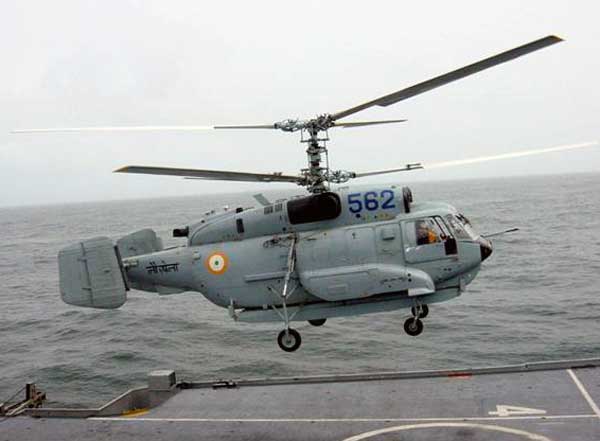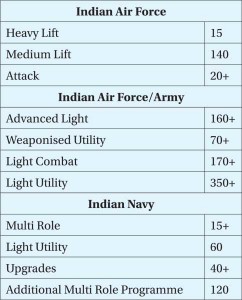Maritime Aspects
It was at sea that the helicopter came into prominence based on the lessons of World War II, especially in the anti-submarine role. Anti-submarine measures to safeguard NATO sea supply lines relied heavily on carrier-based aircraft and helicopter submarine hunting platforms. The ability of the helicopter to operate out of restricted spaces and to hover makes it an ideal anti-submarine platform for search and acquisition of undersea targets and for attacks with near impunity since the submarine itself cannot attack a flying machine. In addition, the helicopter could use active sonar for searching without the risk of revealing its position unlike submarines and surface ships. In the area of mine counter measures also the helicopter could undertake mine sweeping with minimal risk unlike surface ships.
Just maintaining control over the helicopter is a challenge at high altitudes…
Increased effectiveness of the combination of high speed, high altitude bombers and surface ships armed with anti-ship missiles make warships more vulnerable. This combined with carrier-based strike aircraft are the air threats facing navies today. To counter this, Airborne Early Warning (AEW) is essential and for a carrier group operating far outside the reach of friendly shore-based aircraft, AEW and AD of the carrier groups had to be with organic assets. Size limitations of aircraft that can be operated only from super carriers as well as space constraints on the carrier mean that large aircraft cannot be embarked and only a limited number of smaller aircraft can be taken onboard. Helicopters and tilt rotor hybrids with AEW capability are the best solution for smaller carriers although their radar coverage would be constrained by altitude limitations of the platform. Replenishment at sea is and inter-ship transfers are roles tailored for helicopters. SAR has been a major role since the Korean War days. Helicopters also provide much needed mobility to forces in amphibious operations and air support to ground forces at the beachhead if fixed-wing assets are not available, provided the air threat is manageable. Even small ships can have an air component for a multitude of tasks including surveillance, rescue, missile guidance and data relay.
The Indian Scenario
The concepts relating to employment of helicopters in combat that have been tested in the field, have taken place in situations of asymmetry as far as technological capabilities of opposing forces are concerned. This also holds true to some extent for support operations both at sea and on land. Extrapolating these concepts and the few results available from battle scenarios in our context, benefits only the helicopter manufacturer. Lessons and tactics refined in asymmetric warfare situations elsewhere may be of use to us in low-intensity conflict operations such as counter-insurgency operations. They will not hold good in conflicts between matched adversaries. We are faced with two potential adversaries with home grown or acquired technological capabilities at least equal to us. Marked asymmetry of forces in our favour as far as technological capabilities go will not exist across the board in a military conflict with the important adversaries in the region.
Attack helicopters are best used in small numbers against specific value targets in surprise attacks…
Two most important natural factors beyond the control of any military force are terrain and weather. Weather affects military operations to an extent determined by the technological capabilities of weapons systems. We are finally acquiring a night and adverse weather helicopter capability. Helicopters are usually more vulnerable to extreme wind and turbulence because of their very design and inability to fly above severe weather areas. Terrain is the one factor that is of far more importance in our areas of conflict than is the case elsewhere. Our land borders in the North are at altitudes that are often higher than that of the highest mountain peaks in most parts of the world. Aircraft performance in terms of power and lift decrease with increase of altitude. In the case of helicopters, this degradation is far more pronounced. Just maintaining control over the helicopter is a challenge at high altitudes. Maneuverability for combat operations becomes close to impossible. Our helicopter gunships could not even get over the passes to approach combat zones during the Kargil operations. Like most combat helicopters, they were designed for operations at much lower altitudes. The sad fact is that this limitation was not even known to some of our ground forces commanders, leading to inter-service squabbles still going on 15 years later.
Attack helicopter operations in close support of troops at high altitudes at the limits of controllability do not appear to be a workable proposition. All AD systems including SAMs have greater ranges at higher altitudes, the terrain provides good cover to defenders; it masks the field of vision of both crew and sensors in the helicopter and turbulence, clouding and low visibility restrict operations to a small window of opportunity. To keep out of range of SAMs located on ridges, the helicopter is forced to fly even higher thereby degrading weapon accuracy. These factors affect all helicopters but attack helicopters have to operate in a more hostile AD environment and execute violent manoeuvres for weapon delivery and evasion of ground fire. At most, they can be used for special missions in lower threat AD environments where surprise could work in their favour.
Mobility in the mountains is a big problem, aggravated greatly in our context by very poor surface infrastructure. Medium and heavy-lift helicopters are force multipliers in this area. Troop induction, Special Operations, logistics resupply and Casevac using helicopters become almost imperative in our context. For all this to work we need helicopters with enhanced high altitude capabilities as well as the avionics to operate at night and within limits, in adverse weather. In the plains and deserts, employment of masses of attack helicopters in a dense AD environment in close proximity to ground forces fighting enemy forces with similar capabilities has not been done in actual combat and tried only in simulations. Positive identification to avoid fratricide in the confusion of tank battles is a major problem both for the attack helicopter and ground AD systems. Attack helicopters are best used in small numbers against specific value targets in surprise attacks. The use of Apache helicopters at night against forward AD early warning radars in Iraq in 1991 is an example. In low threat areas, they can be effective in fire suppression roles when escorting troop transport helicopters as well as in the anti helicopter role. The use of helicopters in low-intensity counter-insurgency situations has been dealt with in an earlier article.
Replenishment, SAR, support for amphibious and Special Operations launched from ships – all require helicopters…
At sea, we have a Navy woefully short of submarines, mine counter-measures vessels, deploying obsolete ship-based AD systems for the most part and our carriers at best can embark two squadrons of fighter aircraft. The helicopter fleet is insufficient and obsolete. The shortage of submarines places a greater burden on helicopters for anti-submarine operations for which they are well suited as mentioned earlier, provided they have an effective mix of sensors and weapons. The same is the case for mine clearing operations especially in choke points such as outside major ports. With limitations of carrier size to house and operate carrier borne fixed-wing Airborne Early Warning and Control Aircraft (AWACS), the available option is to use helicopters or hybrid tilt-wing machines as AWACS platforms when surface forces operate far from land-based air cover.
Replenishment, SAR, support for amphibious and Special Operations launched from ships – all require helicopters. Terminal AD against missiles attacks at sea by using helicopters with Air-to-Air Missiles is an option given the poor state of our integral AD systems on ships. Surveillance and interdiction in low-intensity conflicts such as anti-piracy and anti-hijack situations can be done with a mix of Unmanned Aerial Vehicles (UAVs) for surveillance wherever possible and armed troop-carrying helicopters for physical intervention.
There is a need for all-weather helicopters with night vision capabilities for Special Operations…
Force Requirements
Given the state of our equipment and the likely tasks, we have to prioritise. Acquiring large numbers of attack helicopters for possible deployment in unvalidated roles as flying tanks in an armoured forces conflict just because some other armies have them is a waste of precious resources and is unaffordable. We should stay with limited numbers, centrally controlled and tasked for special surgical operations. Hankering after the US Army, which fielded more helicopters in an Airmobile division in Vietnam than our total inventory of military helicopters, is not a practical approach.
We require helicopters with enhanced high altitude capabilities for use in the mountains including heavy-lift versions, complemented by less powerful versions for operations in the plains. There is a need for all-weather helicopters with night vision capabilities for Special Operations.
Naval requirements include anti-submarine and mine counter-measures variants, AWACS platforms and medium-lift helicopters and armed variants capable of being embarked on carriers as well as on bigger surface ships. Smaller helicopters that can be deployed on smaller ships are also needed. Some assessments available in the open fora of the modernisation and upgrade programme wish-list in terms of numbers gives an idea of its magnitude, making it possibly the biggest rotary wing acquisition in the world.







Gp Capt – a big question – why does the Air Force need to hang on to Rotary Wing assets. Helicopters are mainly used by the Army and are provided by the Air Force. It’s a mismatch, for obvious reasons. The first fall guy in this mismatch (I call it organizational ego) is the training. The Air Force is not able to meet the Army’s training requirements. There is a tremendous shortfall of making assets available for training. To be honest in most cases the Army use trees to practice SHBO training. That’s rather shameful. Secondly the quality of training is poor because the Air Force throws its safety factors in the face of the Army and in the end the training is not realistic, it’s modulated and done just for the sake of doing. I had to sit in the cockpit once to guide the Helicopter to the LZ because the pilot couldn’t find it. I‘ve often heard the Air Force saying in war we will do it. But that doesn’t give the Army the kind of confidence that’s need to plan its operations. There is always a doubt about the Air Forces capability. Empire building must stop, let’s be practical. All Rotary wing assets should be part of the Army. The Air Force can have its share of RW assets as per its requirement purely to perform tasks for the Air Force. I am a Paratrooper and have years of experience in the field of SHBO.